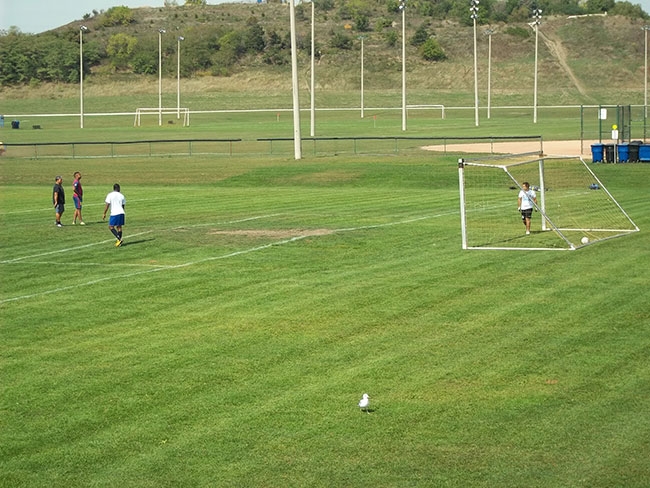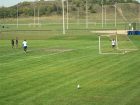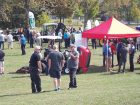
Features
Agronomy
Overseeding is critical in sports turf field coverage
Overseeding keeps weeds in check, provides safer, more playable surface
December 6, 2016 By Mike Jiggens

The importance of overseeding sports fields cannot be overstated. Abundant wear leads to bare spots. If these sections of a field are ignored, playability is compromised, and injuries to athletes are inevitable.
“Overseeding is the key piece to increasing the overall turf coverage,” said John Bladon, principal with the Chimera Group, in an address to sports turf managers in September at Sports Turf Canada’s annual fall field day at Toronto’s Etobicoke Olympium at Centennial Park.
Since an Ontario-wide ban on pesticide use was enacted in 2009, sports turf managers have been challenged to keep field conditions up to standard without the aid of traditional chemical inputs. Overseeding is one such strategy to have increased in popularity in recent years.
Bladon said overseeding is no longer strictly a fall practice. With the amount of activity a municipal sports field typically sees, overseeding should be done ideally in the months of June, August and October, he recommended as a minimum.
“The success of these programs depends on you being out there at the right rate and as frequently as possible, especially as scheduled amounts of play continue to rise.”
Although more frequent overseeding is more desirable, Bladon acknowledged that some municipalities are subject to “crunched” budgets and cannot afford to spread seed in preferred amounts and frequencies. Sports turf managers might wonder if they should split up their seed allotment over a number of seasonal events, but Bladon cautioned good results are not likely to be realized if rates are reduced. If budget limitations force a field manager’s hand, he would be best to seed with the appropriate rate in one application instead of spreading it across four or five events.
Bladon said he has walked fields where it has been apparent that overseeding with perennial ryegrass was done at lower than desirable rates. He presented photographs to his audience of bare spots where a less-than-ideal catch was realized due to inadequate seeding rates. Uneven playing surfaces due to bare spots can produce tripping hazards and other safety issues.
Overseeding can also play a role in weed control. In trial plots, it has been determined that overseeding with perennial ryegrass can reduce dandelion cover by about 12 per cent which Bladon speculated could be the result of the turf species’ comparatively rapid germination. In trial plots where dandelion coverage ranged from 14 to 30 per cent, overseeding with Kentucky bluegrass had no effect on the amount of weed cover while using perennial ryegrass reduced the coverage by about 12 per cent.
Often, it is the desire of the particular user group which influences a sports turf manager’s decision as to which seed type to choose.
“There is a constant demand from athletes out there to have turf cut short.”
Bladon said the shorter the turf, the faster and more aggressive such sports as soccer and football can be played. Favoured mowing heights will drive the decision-making process in determining which type of seed should be put down, especially for higher-category fields versus lower-category playing surfaces.
If a field is mowed at three inches, it is sufficiently long enough to present a tripping hazard to younger children. However, longer heights of cut generally keep weeds in check better than shorter cuts. In trial plots, heights that ranged from a half-inch to one inch produced about 14 per cent weed cover. Once mowing heights transitioned to 1½ to two inches, the amount of weed cover dropped significantly.
Bladon said there is turfgrasses available on the market today that allow for lower mowing heights and good weed control, but require increased mowing frequencies and stepped up amounts of nitrogen.
Most offer good recovery because there is a greater density at a lower height of cut. Some minor decline in recovery from divoting on fields with lower heights of cut has been realized, however.
“It’s not huge or not significant, but it’s something to bear in mind.”
Bladon said it might be a matter of boosting in some spots to ensure the turf’s recuperative energy is kept up.
Sports turf managers favouring Kentucky bluegrass from a management perspective may wish to consider other species if athlete demand pushes for a faster surface through a lower height of cut. When considering such alternative species, however, it is important to understand the additional costs that may be associated with maintaining them, including added labour and the cost of equipment and fuel.
Sports turf managers, like all industry professionals, like to adhere to the “one-third rule” in which turf is mowed at a frequency that results in only the top third of the blade getting cut.
“We need to be conscious of our height of cut and growth rate in determining those frequencies.”
Growth rate is influenced by the amount of available nitrogen, the moisture at the time, as well as temperature and season length. Each contributes to the amount of growth experienced.
If a sports turf manager wishes to maintain a field at one inch, he will have to mow at the point when the plant reaches 1½ inches. If the desired height of cut is two inches, “you have the luxury of waiting until that plant reaches three inches to remove that one-third.”
Bladon said if two adjacent fields are mowed at different heights, the one cut shorter demands a greater mowing frequency. He cautioned that selecting species conducive to lower mowing heights comes with a price.
“It’s one thing to buy great seed, but the evolution of how we go about seeding has certainly happened, and happened rapidly and radically in the last three years.”
Seeding methods have come a long way over the years. It’s much more than simply throwing seed into a broadcast spreader and spreading everywhere. Bladon said much more precision is involved today as well as greater efficiency in achieving ideal seed-to-soil contact.
The contact is enhanced when seed is placed at the proper depth whereby it receives the protection it needs to provide maximum success. Newer equipment features rotating vertical tines that cut slits for placement of the seed. Minimal organic matter disruption is realized at the surface, thus increasing infiltration and allowing for gas exchange.
“So there’s a side benefit to using these units.”
A strong bluegrass population that is likely to spread is apt to branch out when the plants are vertically severed. In time, with a nitrogen application, the existing population will sprawl out, Bladon said.
Managing the “fields within the field” is crucial, he said. On a soccer field, for example, the perimeter or outside the boundary lines generally don’t get as much wear. When moving inward toward the centre of a field, wear patterns begin to build, and it can be extreme in the goalmouth areas.
“In fact in some spots there is an excess of thatch. There are fields within the field that almost dictate you have to customize your management, and that includes overseeding.”
Bladon said he recently saw a contractor who thought “outside the box.” He placed buckets of perennial ryegrass seed at the side of his mower, broadcasting the seed into the goalmouth areas during each mowing event.
“So there’s a constant wave of seed germinating in those goalmouths all season long.”
Strategies such as that can provide better service, increase a turf manager’s frequency and reduce risk to the athlete. He must maintain control of scheduling and make adjustments based on amount of play.
Bladon said if a sports turf manager is maintaining both baseball diamonds and soccer fields, he needs to ask himself if overseeding the baseball outfield is necessary—knowing there are only three outfielders at a time creating traffic—or if he should re-invest his overseeding budget into the extreme wear areas of a soccer or football field.
The combination of overseeding and nitrogen application are the two biggest strategies when, planned together and executed intelligently, offer the best chance of success, Bladon said, adding there must also be an adequate budget available for both.
The sports turf manager must manage the expectations of the users and communicate with them about what is being done on the fields. Bladon said user groups should be informed about when fields are to be fertilized and when overseeding is to take place. The influence sports turf managers have over their user groups with whom they are communicating can have a profound impact on how both the manager and what he does are perceived, he said.
Turf managers should also be conscious of how a site works, including the chemical and physical limitations of the soil, the quality of drainage, and both the quality and quantity of water. These must be taken into consideration when selecting the right seed, Bladon said.
Site data should be collected, including basic soil samples, thatch measurements and water quality “so that you can make good decisions about your inputs on an annual basis. Sustainability must also be kept in focus all the while, he added.
“Can I continue to do this within the confines of my budget? Can I continue to do it this way? Do I need to do it more efficiently?”
Bladon said when asking such questions and posing them to other team members, a sustainable path will be found.
Print this page

